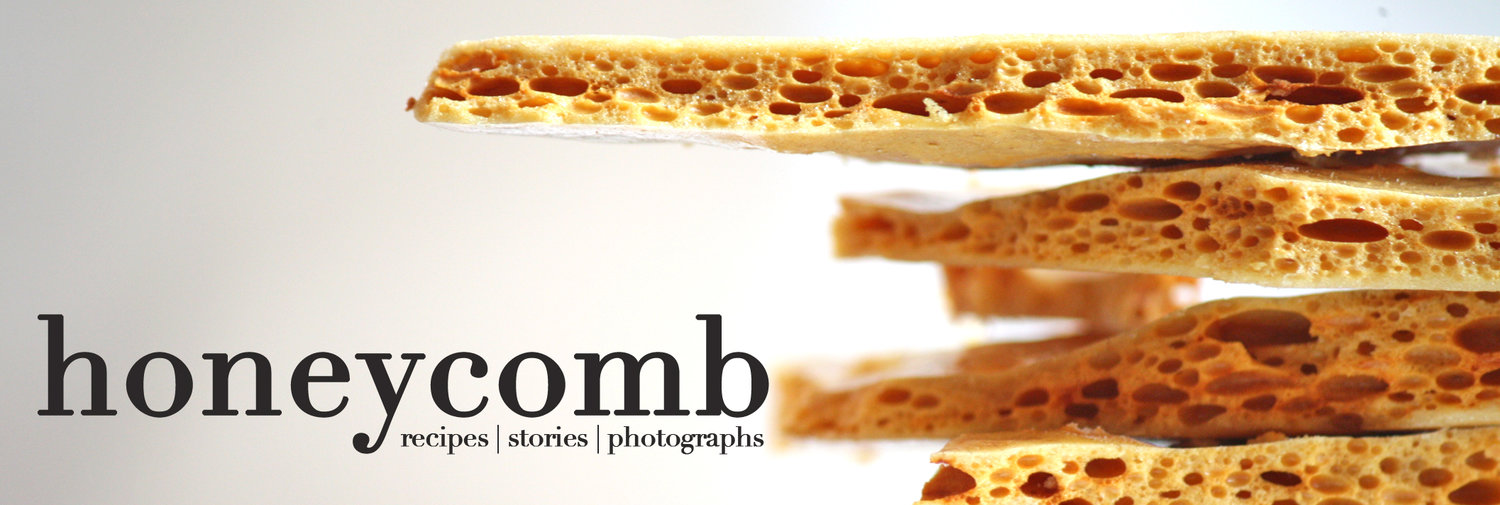Honeycomb Ice Cream for my 100th Post!
I am very excited to say that this is officially my 100th post on Honeycomb. Just a month shy of when it all started 4 years ago, I can’t believe that number 100 is already here. I also can’t believe that, when averaged out, that means I’ve done one post about every 2 weeks. I thought I was way lazier than that so that’s just crazy.


It’s a bit of a strange feeling to get to this point though. I will admit that in the 4 years, there are have been many times where I simply thought about giving it all up. When I started, the food blog thing was certainly an up-and-coming fad but still not too widespread. I had these grandiose ideas that one day some fancy pants food magazine would give it a shout-out and the popularity would grow rampant. But after a long time of that not happening and food blogs becoming something that seemingly everyone and their mother had, I started to lose a bit of steam. What was the point if no one was reading it?
But every time I would get like that, something would pull me back. Maybe someone would tell me that they shared it with a friend or that they cooked one of the recipes and it turned out great. Something little but more than enough to make it all seem worth it again. The blog has changed a lot from post 1 to post 100. It started with a bit of a hippie health blog vibe, moving into angsty posts from my days spent trying to find a job, and shifting into what it is now which focuses heavily on the photography and seasonal eating with travel dining guides thrown in whenever I take a trip. I’m quite happy with where it is today and seeing how it has developed and I continue to be so glad for those moments that keep it all going!


So, to celebrate, what could be more appropriate than some honeycomb ice cream! This is probably my simplest ice cream yet but extremely satisfying. The ice cream base is straight up vanilla custard. It’s crazy sweet but unapologetically so. It gets a fantastic crunch and extra layer of flavor from handfuls of crushed-up honeycomb candy throughout. The best part is, the candy starts to melt a little in the freezer too, giving the ice cream a burnt sugar swirl. To balance out the sweetness, I highly recommend enjoying with some dark chocolate sauce and a sprinkle of some flaky sea salt (believe me, it’s fantastic) or some nice tart raspberries. And, since were celebrating here, rainbow sprinkles. Obviously.



Honeycomb Ice Cream
Makes about a quart
Recipe from Yossy Arefi via Food 52
Ingredients
For the Honeycomb
½ cup granulated sugar
¼ cup golden syrup or dark corn syrup
1½ tsp. baking soda
pinch of salt
For the Ice Cream
2 cups heavy cream
1 cup whole milk
1 cup sugar
4 egg yolks
1½ tsp. vanilla extract
pinch of salt
Begin by making the honeycomb candy. Line a baking sheet with parchment paper. In a medium saucepan, combine the sugar and syrup and stir until it becomes a paste. Place it over a medium heat. Let it cook and bubble away until the sugar is melted and the mixture is a dark maple color. Do not stir with a spatula but you can slowly tilt and swirl the pot occasionally. This should take about 5 minutes.
Once ready, whisk in the baking soda and salt. It should bubble and foam. Quickly pour the mixture onto the sheet pan. It doesn’t matter if it’s smooth, just get it all onto the sheet as fast as possible. Let cool completely before touching again. Once cool, break up into small dime-size pieces. Store at room temp in an air-tight container until ready.
To make the ice cream, combine the cream, milk, and sugar in a medium saucepan. In a separate bowl, whisk the egg yolks together. Place the saucepan over medium heat and stir until the sugar is dissolved. When the mixture starts to get small bubbles around the outside edge of the pot, remove from the heat. Slowly pour a little bit at a time into the bowl of egg yolks, while whisking. Once you’ve added about a half-cup, pour the warmed egg yolks back into the pan with the milk mixture.
Return the saucepan to the stove over medium heat. Continue cooking and stirring constantly until the mixture is thickened and coats the back of a spoon. This will take about 4-5 minutes. Remove from the heat and stir in the vanilla and salt. Pour into a container and let sit in the fridge overnight.
Then next day, churn the ice cream according to the machine’s instructions. Just before the ice cream is done churning, add in about ¾ cup to 1 cup of the honeycomb candy. Transfer the ice cream to a freezer-safe container and let freeze for at least 3 hours before eating. As mentioned above, it’s agreat with chocolate sauce, sea salt, and berries.




















